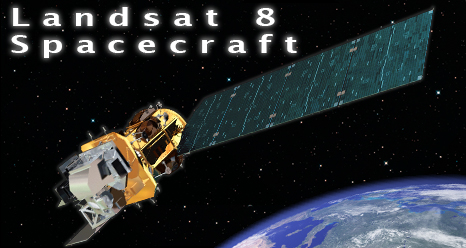
Landsat 8 consist of two major segments: the observatory and the ground system. The observatory consists of the spacecraft bus and its payload of two Earth observing sensors, the Operational Land Imager (OLI) and the Thermal Infrared Sensor (TIRS). OLI and TIRS collect Landsat 8 science data. The two sensors coincidently collect multispectral digital images of the global land surface including coastal regions, polar ice, islands, and the continental areas. The spacecraft bus stores the OLI and TIRS data on an onboard solid-state recorder and then transmits the data to ground receiving stations.
The ground system provides the capabilities necessary for planning and scheduling the operations of the Landsat 8 observatory and the capabilities necessary to manage the science data following transmission from the spacecraft.
The Landsat 8 spacecraft, built by Orbital Sciences Corporation, has a design life of 5 years, but carries sufficient fuel for 10 years of operations. + 1/48 scale model of Landsat 8 & assembly instructions (PDF, 5 Mb)
Excerpt: LDCM Spacecraft
NASA awarded a contract for the LDCM (Landsat 8) spacecraft to General Dynamics Advanced Information Systems (GDAIS) in April 2008. Orbital Science Corporation (Orbital) subsequently acquired the spacecraft manufacturing division of GDAIS in April 2010. Orbital… assumed responsibility for the design and fabrication of the LDCM spacecraft bus, integration of the two sensors onto the bus, satellite-level testing, on-orbit satellite check-out, and continuing on-orbit engineering support under GSFC contract management (Irons & Dwyer, 2010). The specified design life is five years with an additional requirement to carry sufficient fuel to maintain the LDCM orbit for 10 years; the hope is that the operational lives of the sensors and spacecraft will exceed the design lives and fuel will not limit extended operations. The spacecraft design calls for a three-axis stabilized vehicle built primarily of aluminum honeycomb structure with a hexagonal cross-section. It [was] built in Orbital’s spacecraft manufacturing facility in Gilbert, Arizona.
Excerpted from Remote Sensing of Environment 122, James R. Irons, John L. Dwyer, and Julia A. Barsi , The next Landsat satellite: The Landsat Data Continuity Mission, 11-21, Copyright 2012, doi:10.1016/j.rse.2011.08.026, with permission from Elsevier. Courtesy of the journal Remote Sensing of the Environment.

